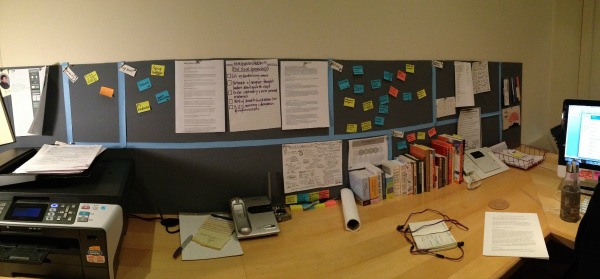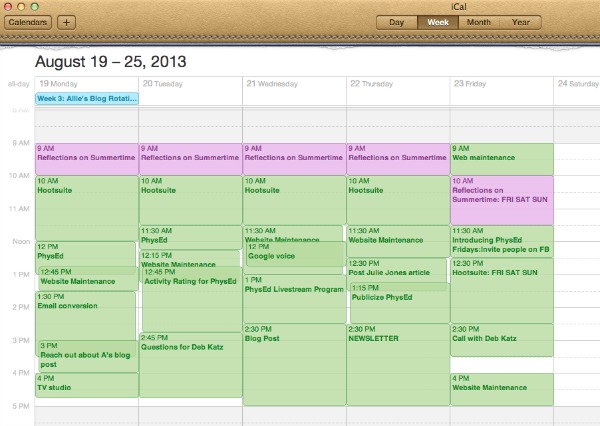How to structure your time when you’re wearing many hats
When you’re running a small or start up nonprofit, time management gets messy. Which hat do you wear and when? How do you develop your organization while managing all of your daily operations?
I made up exactly half of our nonprofit team when we started in 2012 and I managed the responsibilities of a full staff: communications, development, marketing, and administrative. It didn’t take long for me to realize that I had to systematically structure my time in order to stay on top of the day-to-day and expand our nonprofit to the international reach it has achieved.
So how do you maximize the time and money you spend managing your responsibilities?
Remember, “Free” is Not Free
Free is such a delicious word. Naturally, we’re huge fans of all of the free, digital tools created to help make cultivating an online network easier to do. But free does not mean donated. The time of any small staff is incredibly valuable. When I first started exploring online tools it was easy to focus all of my energy there—I had the feeling I was taking a shortcut to success! “If I spend enough time gaining Twitter followers using all of the free tools available then we’ll rake in supporters!” Nope. Your followers don’t necessarily translate to dollars. For a nonprofit to survive beyond infancy, it needs money and it needs it fast. Don’t ignore amazing free tools like IFTTT, Buffer and Mention but do schedule your time accordingly.
Stop, Look and Listen
There is a lot of pressure for startups to keep moving forward no matter what. But if you block off your day without any time to put your ear to the ground you will cripple your organization’s development. Social media is the best way to hear what your constituents want and need from your nonprofit. And if you listen closely, you can give them something that will surprise and excite them! Take a moment every morning (usually, I take about 30 minutes) to ‘listen’. Read blogs by members of your target audience. Follow them on Twitter. Friend them on Facebook. Do you know what your donors and key constituents want? What do they do when they’re offline? What is the top query they search for on Google? If you don’t know, it’s time to listen. Google search terms related to your audience. See what they’re saying on forums and other websites. If you’re anything like me, at first it will feel like you’re wasting precious time or slacking off. But this has proved crucial to our success as an organization.
Case study: My nonprofit’s mission is to provide emotional, social and informational support to family caregivers with their incredibly time consuming and stressful role. I had a bit of a learning curve since I had never personally been a caregiver so I took at least two hours a day to read hundreds of blog posts, not about family caregivers but by family caregivers. That was the most significant thing I have done to brand our organization. It helped me develop an angle and tone that relates to the caregiver in need, rather than instructs them. For one, all of the bloggers hated being told to “take care of themselves” even though almost every nonprofit aimed at helping caregivers had the token “self-care” blog post. So we crafted a post that addressed the truth behind self-care and our audience loved it. They felt heard and understood.
Don’t Waste Your Time on Filler
Measurements are important indicators of the input and output of your nonprofit but some industry benchmarks do more harm than good. Consider, for example, the number of blog posts you are publishing weekly. If you are trying to meet a fixed number, you’ll likely end up posting some filler content during a busy week. This is a waste of time and detracts from your credibility as an industry thought leader. Remember how much time it took in school to make your copied homework sound original? Spend your time writing quality blog posts rather than trying to hit a benchmark. Give your readers filler content and they will tune you out.
Writing a quality blog post takes a great deal of time and effort. If you haven’t gotten to that point already, you will be hard-pressed to write a post each week. One way to troubleshoot—use a blog rotation where staff members alternate writing one post every two or three weeks. By delegating and sharing the responsibility you can harness a broader and more interesting perspective every week. Beyond blogging, are you pushing quantity over quality in other areas of your organization? What else feels like a checkmark on your to-do list but not really an accomplishment? Consider your answer to be a litmus test—are you achieving results or are you running on rote?
Relationship ‘Flossing’. It’s Annoying But You Have to Do It Daily
If your start-up falls, will anyone hear it?
Make some noise by reaching out to relevant people and organizations just to say hi (with your voice, not your keystrokes!) and let them know about your mission, discussing partnership opportunities when appropriate.
Building these new relationships is something you need to do every day, even if it feels tough or tedious. Our Development Director does daily outreach over the phone, between 10am and 1pm, the time period people are most receptive to taking a call to explore new opportunities. Rather than setting aside a block of time, try using the One-Page Rule. When you start your morning outreach calls, take notes recording who you called (if you didn’t reach them who you talked to), their number, when you called, what you discussed, and any follow up notes. When you’ve completed a page, put the phone down. The “One Page Rule” is a great measurement of the quality of conversations rather than the quantity—if you had an engaging conversation, you end up taking more notes and will likely have more follow up work to do!
Make Your Priorities Visible
In our first few months, it was incredibly hard to prioritize—we were simultaneously chasing down Oprah and registering our domain name. The creative juices were flowing but we couldn’t tackle every possibility at the same time. When we would document our ideas on the computer or in notebooks, we couldn’t engage with them as much. We needed something messy and interactive, conducive to creativity and highly visible. So we started a “Priority Board.”
We created spaces for “priority,” “up next,” “future,” and “current and ongoing.” Our “idea pen” is a space for ideas that don’t fit into our current or future plans (yet). The post-its are color coded by the category of idea, for easy reference, and initialed when necessary, for accountability.
Our priority board forces us to choose what needs immediate attention and what might sound like a good idea but will end up getting nixed later in the game. It also creates a space to run ideas in progress by another person and creating this “air time” makes room for new ideas to develop.
Creating Time Metrics
As your nonprofit grows, you’ll need to constantly revise your schedule—new responsibilities come up and others reach their conclusion. See where you’re wasting time by keeping track of what you do each day and how much time it took. Your time doesn’t need to be set in stone but you’ll have a much easier time scheduling your responsibilities if you have a backbone to your day.
You’ll notice that, for the most part, I start off my morning the same. My non-negotiable responsibilities: designing a daily “CareCard” (a graphic with an inspirational quote to be published on Facebook), creating, finding and scheduling social media for the day; website maintenance; weekly email marketing campaign. The rest of the day is open to the “Priority Board.”
Let go of the rest
You won’t be able to accomplish everything your organization would like to do. That’s normal. And frankly—a relief. What would there be to grow towards and look forward to?
Vet ideas and responsibilities as they come. Let go of the rest.
Remember:
Your time is valuable.
So schedule it wisely.
But not too much.
And only work on quality.



 PRINT
PRINT


